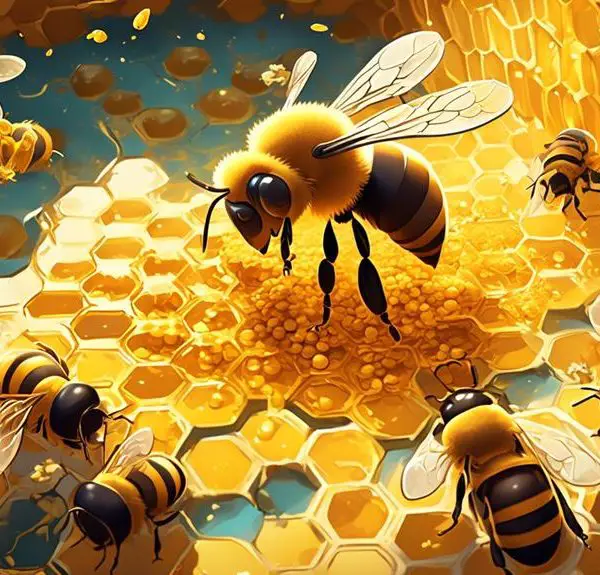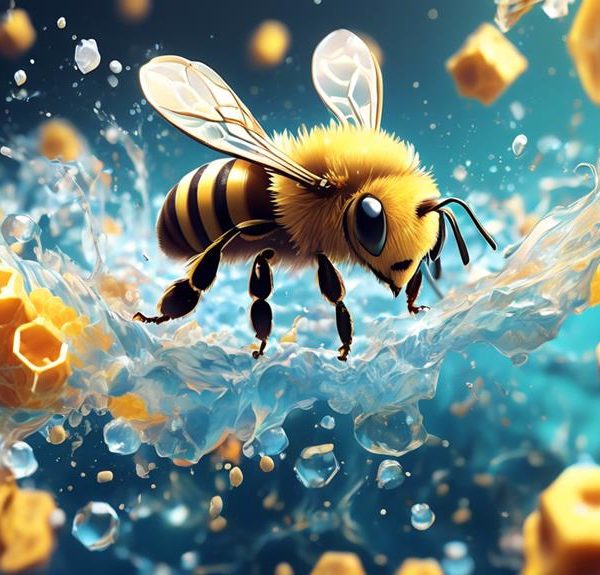Dive into the mysterious underground world of bees and wasps, exploring the ecological secrets they hide beneath your backyard.

Bees or Wasps in Ground?
Dancing in the heart of your backyard, a marauding band of bees or wasps has taken up residence, and they're not exactly paying rent. You see, these insects are more than just a potential sting waiting to happen; they're part of an intricate ecosystem that's constantly at work beneath our feet.
Their ground-based nests can be both a boon and a bane, depending on your perspective and, of course, your tolerance for uninvited guests. Now, wouldn't you want to know the whys, the hows, and the what-ifs of these buzzing tenants?
Key Takeaways
- Ground-nesting bees and wasps have distinct physical characteristics and behavior differences.
- Understanding the life cycle of ground-dwelling insects can help in identifying and dealing with ground nests.
- Bees play a crucial role as pollinators, while wasps contribute to ecosystem balance as pest controllers.
- Safety precautions should be taken when handling ground nests, and proactive prevention measures can help reduce nest establishment.
Identifying Ground Nesting Bees and Wasps
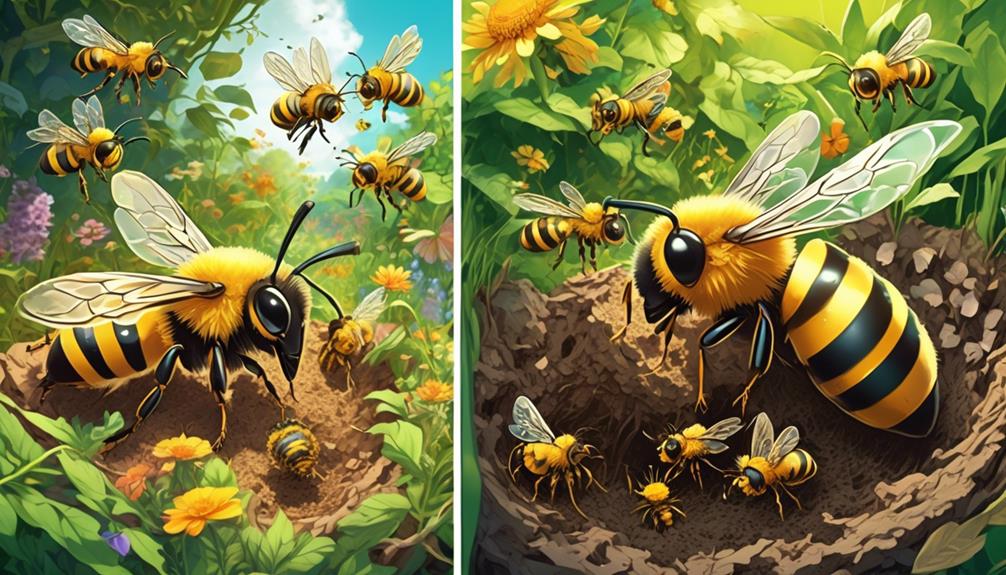
Before delving into the intricacies, it's important to know that identifying ground-nesting bees and wasps involves careful observation of their physical characteristics, behavior, and nesting habits.
By studying the physical traits, you'll notice that ground-nesting bees are usually hairier and rounder, while wasps appear more elongated, often showcasing a sleek and shiny body with a distinct waist.
Your detective work shouldn't stop there. You need to observe their behavior too. Ground-nesting bees are typically less aggressive and more interested in pollen collection, unlike wasps which are predatory and often hover around food sources or garbage.
As for the nests, wasps' ground burrows are generally larger openings and often guarded, unlike the smaller, solitary holes of ground-nesting bees. You'll find the latter's nests primarily in sunny, dry locations with sparse vegetation, while wasps may prefer shaded, damp areas.
Life Cycle of Ground-Dwelling Insects
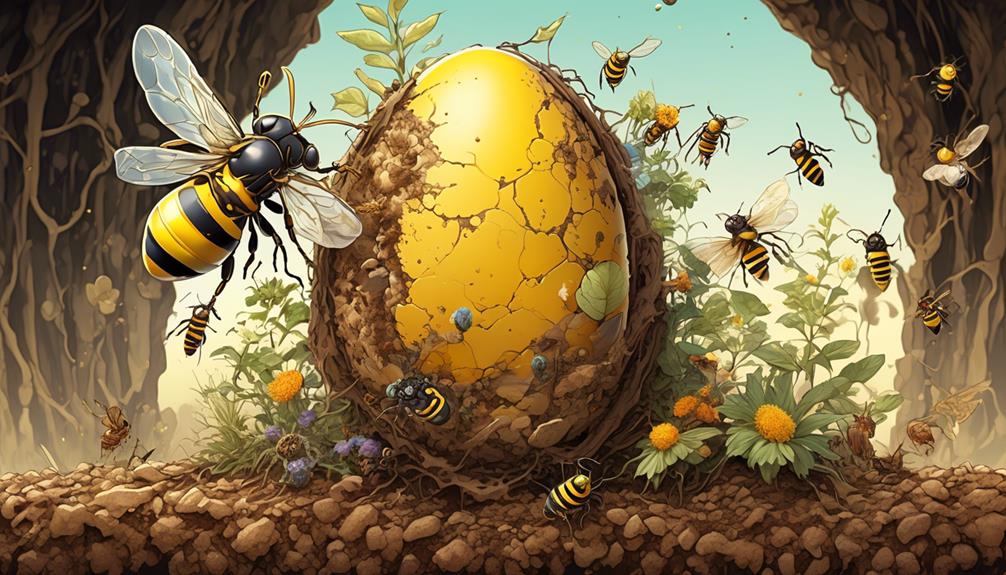
Having distinguished between ground-nesting bees and wasps, let's now examine their life cycles to gain a broader understanding of these intriguing ground-dwelling insects.
You'll find that the life cycle of these insects comprises four main stages: egg, larva, pupa, and adult.
For bees, the queen lays an egg in each cell within the hive. The egg hatches into a larva that's fed by worker bees. The larva then pupates, undergoing a transformative stage within a protective cocoon before emerging as an adult bee.
Ground-nesting wasps follow a similar pattern. The queen wasp lays an egg in each cell within the nest, usually after paralyzing a spider or other insect and placing it in the cell as food for the emerging larva. The larva feeds on the provided prey, pupates, and eventually emerges as an adult wasp.
While their life cycles are similar, there's a crucial difference in their diets. Larval bees are herbivores, feeding on pollen and nectar, while wasp larvae are carnivores, consuming the paralyzed prey provided by their mother.
Understanding these life cycles can help you better manage and appreciate these valuable insects.
Roles in the Ecosystem: Bees Vs Wasps
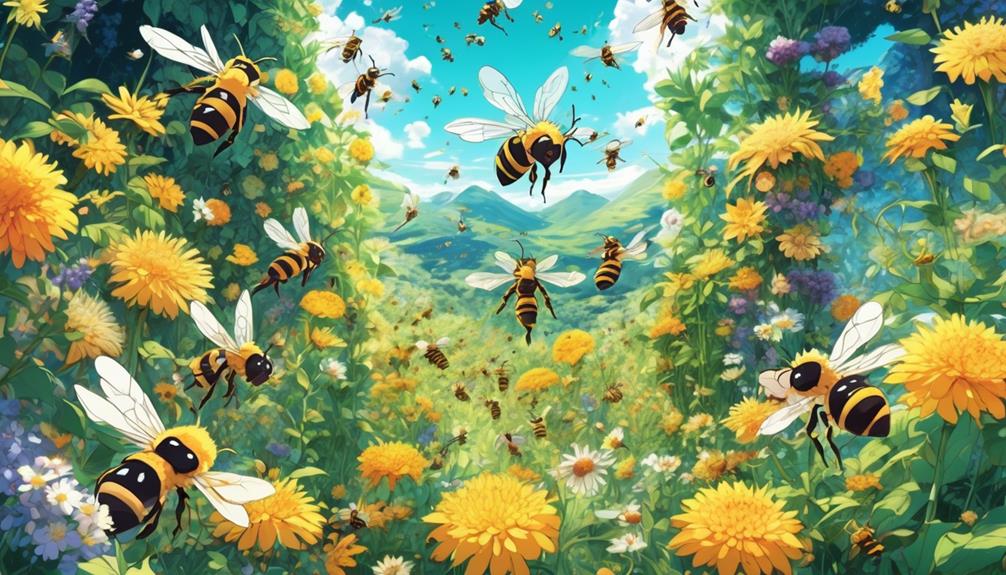
Delving into the ecosystem, it's important to recognize the distinct roles that bees and wasps play, each contributing significantly, but differently, to our environment.
Bees, as you may know, are crucial pollinators. They help to fertilize flowers by transferring pollen from the male parts to the female parts of a flower, thus encouraging plant growth and fruit production. This role can't be overstated; roughly 70% of the world's flowering plants depend on pollinators like bees to reproduce.
Wasps, on the other hand, are nature's pest controllers. They prey on a variety of insects, including those that are harmful to crops and plants. By controlling these pest populations, wasps contribute to the balance of ecosystems and help to maintain biodiversity.
However, it's not a competition. Bees and wasps, despite their differences, both play vital roles in the ecosystem. Considering their declining populations, it's crucial for us to appreciate and protect these insects.
Dealing With Ground Nests Safely
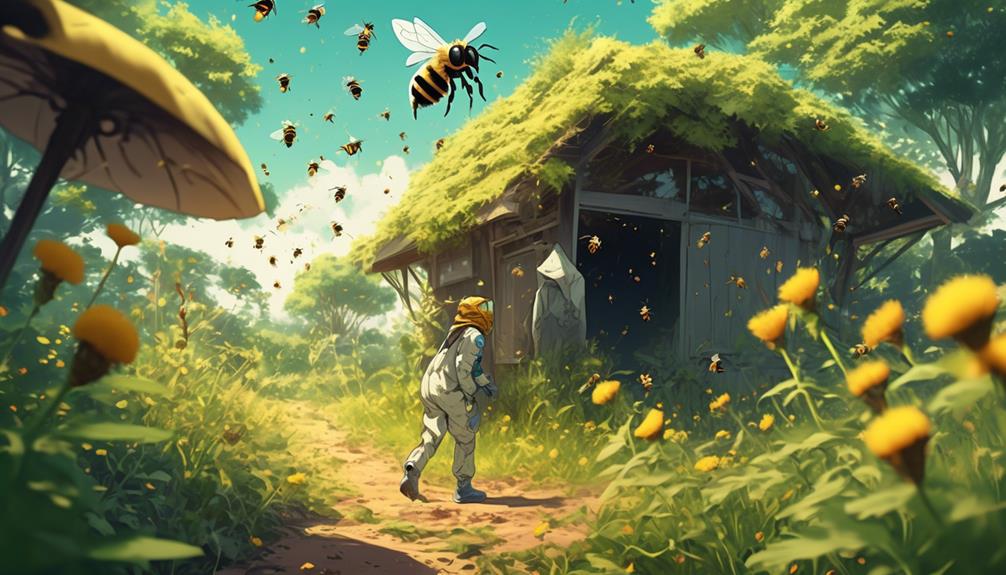
If you've ever encountered a ground nest of bees or wasps in your yard, it's crucial to handle the situation carefully to ensure your safety and preserve the insects' vital ecological roles. These insects aren't inherently aggressive, but they'll defend their nests if threatened.
First, identify the insects. Honeybees are endangered, and their nests should be removed by a professional beekeeper who can relocate the colony safely. On the other hand, wasp nests can be dealt with using approved insecticides after dusk when they're less active.
Ensure you're adequately protected before approaching the nest. Wear thick clothing, gloves, and a veil to protect your face. Move slowly and calmly to avoid alarming the insects.
If an insecticide is necessary, apply it at the nest entrance. Avoid shining lights directly on the nest as this may stimulate activity. Instead, use a red or amber filter on your flashlight as these insects can't see these colors well.
Always keep a safe distance from the nest and let the insecticide work overnight. Check the nest from a distance the next day for activity. If it's still active, repeat the treatment. If not, fill in the hole to prevent re-infestation.
Preventing Ground Nest Establishment
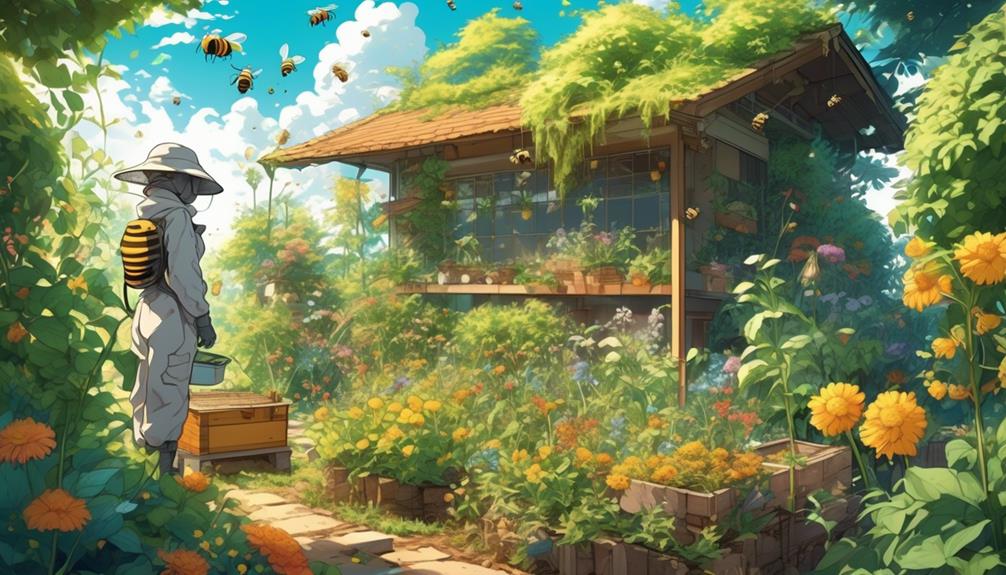
While dealing with existing nests is critical, it's equally important to take proactive steps to prevent bees or wasps from establishing new ground nests in your yard.
Firstly, you should regularly inspect your property, especially during spring and early summer when these insects are most likely to establish colonies. Look out for small holes in the ground, typically with a mound of soil around them. They're often the first sign of a potential nest.
Secondly, consider reducing food sources. Bees and wasps are attracted to sugary substances and protein-rich foods. Secure your trash bins and avoid leaving pet food outside. Also, limit the number of flowering plants in your yard as they can attract bees.
Lastly, you can use insecticides to deter them. Pyrethrum-based products are particularly effective. However, they should be used sparingly and responsibly to avoid harming beneficial insects and the environment.
Always remember: prevention is better than cure. It's less hazardous and potentially less costly to prevent the establishment of a nest than to have to deal with an established one.
With these strategies, you can significantly reduce the chances of a ground nest appearing in your yard.
Professional Pest Control Options
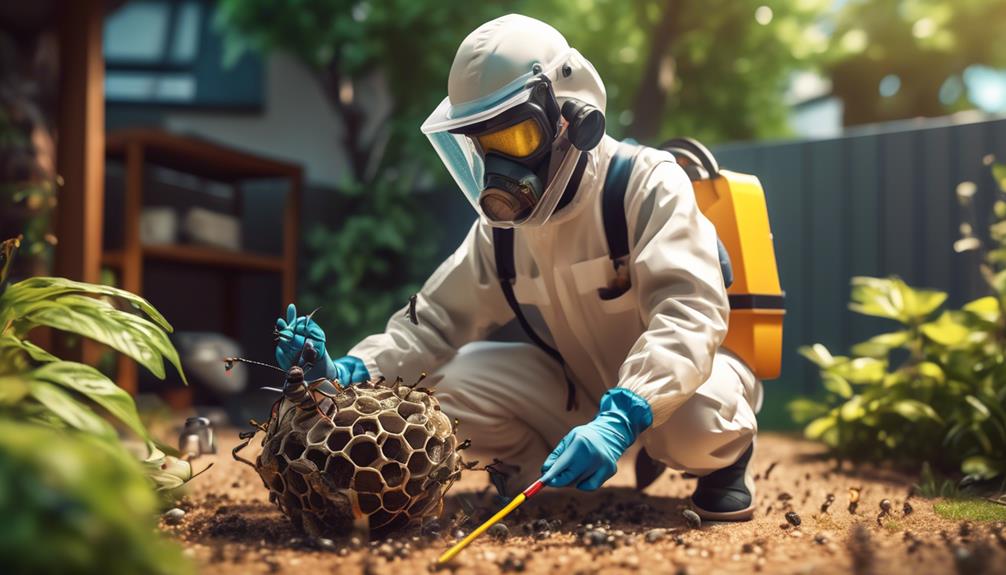
Despite your best efforts to prevent ground nests, you might find that bees or wasps have still managed to establish a colony in your yard, making professional pest control a necessary option to consider. Professionals possess the skills, knowledge, and equipment to safely and effectively remove these pests.
Experienced pest control professionals can identify the species of bee or wasp, which is vital as different species require distinct removal techniques. For instance, some species can be relocated while others must be exterminated. They're also well-versed in the behavior of these insects, which aids in the identification of hidden nests and the best times for removal.
Moreover, professionals are equipped with personal protective equipment to prevent stings, and they use specialized tools to remove or exterminate nests without causing unnecessary harm to the environment. They also apply insecticides that are approved by regulatory bodies, ensuring their effectiveness and safety.
You may feel tempted to handle the problem yourself, but remember, improperly dealing with a nest can provoke an attack, posing a risk to your health. Therefore, it's advised to call in professionals who can handle the situation with utmost expertise.
Frequently Asked Questions
What Are the Primary Differences Between Bees and Wasps in Terms of Their Behavior?
You're asking about behavior differences between bees and wasps.
Bees are typically social, living in large colonies, while wasps can be solitary or social.
Bees are vegetarians, feeding on nectar and pollen, while wasps are carnivores, preying on other insects.
Bees can sting once, dying afterward, but wasps can sting multiple times.
Lastly, bees are often more docile unless threatened, while wasps tend to be more aggressive.
Can Ground-Dwelling Bees and Wasps Pose a Threat to Pets or Livestock?
Yes, they can pose a threat. If your pets or livestock accidentally disturb a nest, they might get stung. Bees usually sting once and die, but wasps can sting multiple times. Reactions can range from mild discomfort to severe allergic reactions.
It's crucial you keep an eye out for nests and take preventative measures to protect your animals. Remember, not all ground-dwelling insects are harmful, but it's better to be safe than sorry.
Are There Any Specific Geographical Regions Where Ground Nesting Bees and Wasps Are More Prevalent?
Yes, certain regions do have higher populations of ground nesting bees and wasps. You'll find them more prevalent in warmer climates, especially deserts and sandy areas. They prefer environments with loose soil for easy burrowing.
However, they're still found globally, just in less concentration in colder regions. It's also important to note that prevalence can fluctuate seasonally, with numbers increasing during warmer months.
How Do Changes in Weather or Seasons Affect the Activity of Ground-Dwelling Bees and Wasps?
Changes in weather or seasons significantly impact your ground-dwelling insects. During colder months, they're less active, often going into a state of dormancy. As temperatures rise, you'll notice increased activity, as warmer weather is optimal for foraging and breeding.
Rainfall can disrupt their habitats, forcing them to relocate. So, you see, shifting weather patterns and seasonal changes directly influence their behavior, survival, and overall population dynamics.
What Are Some Natural Predators of Ground-Dwelling Bees and Wasps?
You're curious about natural predators, aren't you? Many species face threats from predators, including birds, spiders, and even other insects.
Birds, for instance, often swoop down and snatch them up. Spiders weave intricate webs to trap them. Other insects, like dragonflies, can snatch them out of the air.
Also, there are certain mammals, like badgers and bears, that'll dig into nests to feast on larvae.
It's a tough world out there in nature!
Conclusion
In concluding, you've learned how to identify ground nesting bees and wasps, their life cycle, roles in our ecosystem, and how they differ.
You're now equipped with knowledge on dealing with ground nests safely and preventing their establishment. But remember, when in doubt or facing a large infestation, don't hesitate to call in professional pest control.
Understanding these insects better not only helps coexist with them but also contributes to maintaining a balanced ecosystem.

